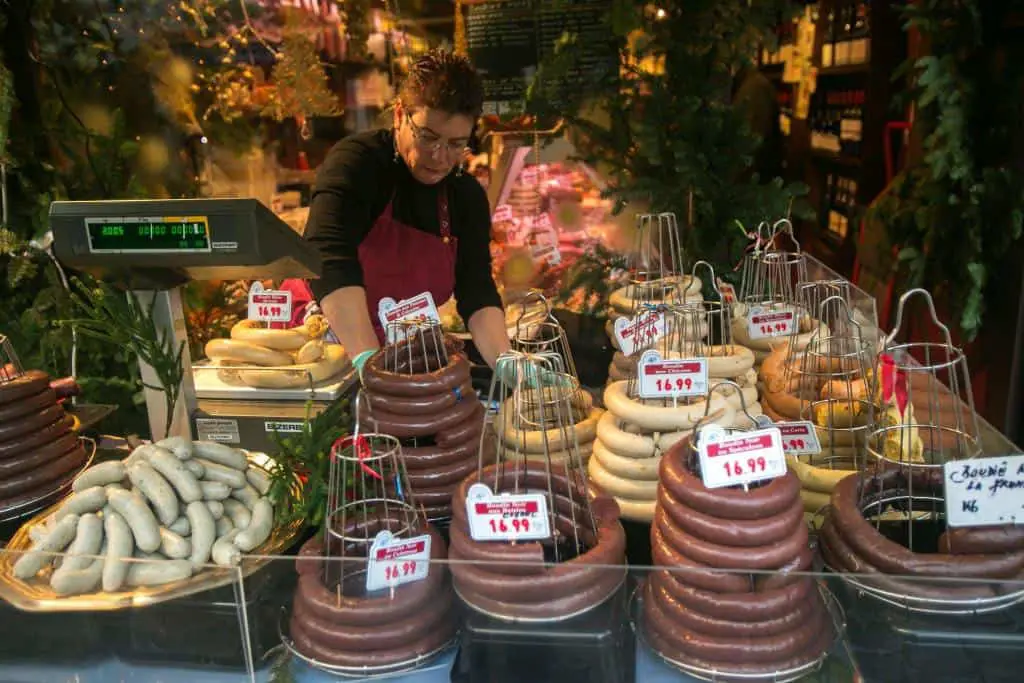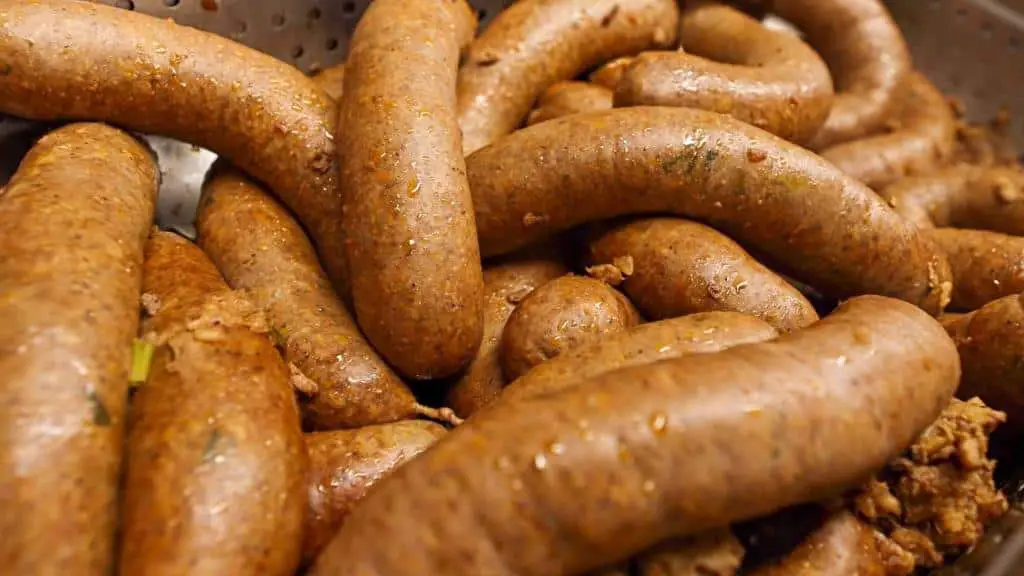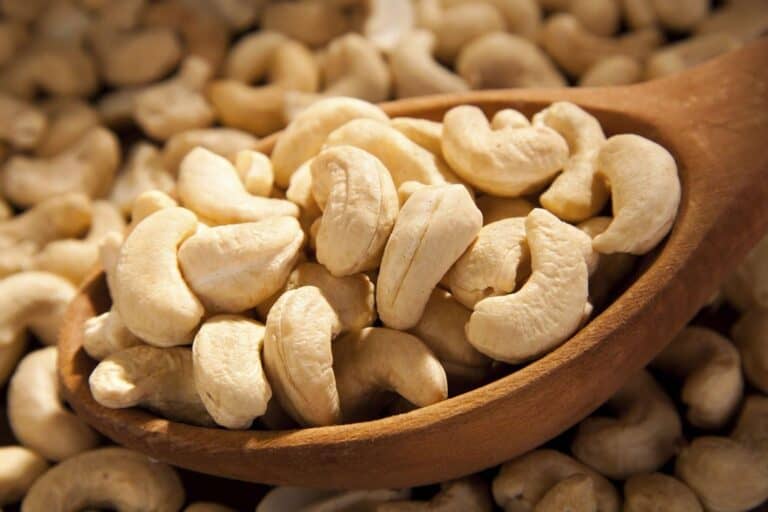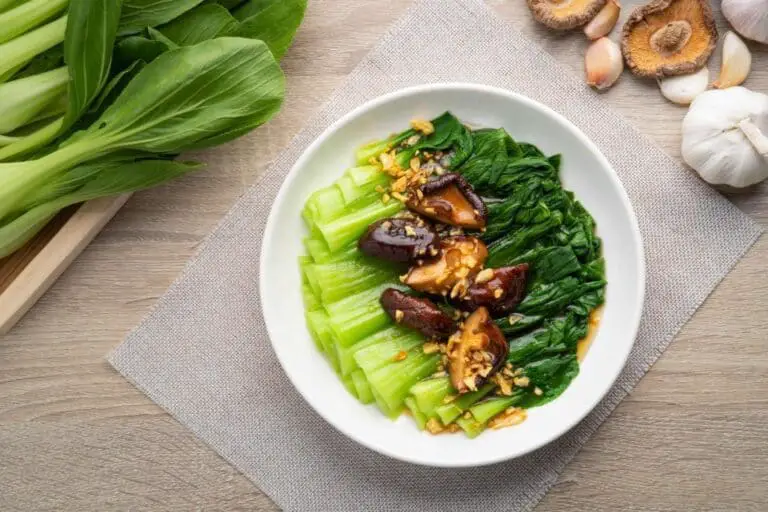Can You Eat Boudin Skin? Is Boudin Casing Edible and Safe to Eat?

In the enchanting realm of culinary mysteries, boudin holds a special place. A delectable fusion of rice, meat, spices, and herbs, this sausage-like dish has delighted palates for generations. Still, a strange question remains: Can you eat boudin skin? Is the boudin casing not only edible but also safe to savor?
Imagine the scene: a plate adorned with a plump boudin sausage, its tantalizing aroma wafting through the air. As you contemplate your first bite, questions arise. Should you peel away the casing, focusing solely on the luscious filling within, or is there more to this delicate skin than meets the eye?
Join us on a flavorful journey as we unravel the intricacies of boudin casing. Discover the history, the textures, the flavors, and the cultural practices that revolve around this culinary gem. By the end, you’ll not only have answers but also a deeper appreciation for the artistry of boudin and the delightful choices it offers. Can you eat boudin skin? Let’s find out together.
Understanding Boudin and Its Skin
Before we delve into the intricacies of the boudin casing, let’s get better acquainted with this mouthwatering sausage. Pronounced “boo-dan,” boudin is a sausage that boasts an extraordinary blend of ingredients. Typically, it features a mixture of pork meat, liver, onions, rice, and an assortment of spices. The outcome is a burst of flavors that tantalize your taste buds with every bite.
What makes boudin truly fascinating is its ability to adapt to regional influences, resulting in various unique types. From the iconic Cajun boudin to the traditional European blood sausage, boudin maintains its essence—a harmonious blend of textures and tastes, with the casing playing a pivotal role.
Let’s now examine the crucial role that the boudin casing plays. This casing is a thin layer that envelops the boudin sausage, holding together its exquisite filling. It serves as both a protective barrier and a vessel for the rich flavors inside, ensuring that each bite delivers a harmonious blend of textures and tastes.
Whether it’s the snappy snap of a fresh casing or the tender embrace of a well-cooked one, the casing adds a distinct dimension to the boudin experience. It’s a testament to the craftsmanship that goes into creating this beloved dish, making boudin a true culinary masterpiece.
Composition of Boudin Casing
Historically, boudin casings were crafted from natural materials like animal intestines, embracing tradition and resourcefulness. In modern times, casing materials have evolved, embracing a blend of natural and synthetic components. This evolution has brought forth variations in casing composition, influencing the texture and taste of the final dish.
The casing, akin to a culinary embrace, enrobes the boudin mixture, lending its unique character to the ensemble.
Can You Eat Boudin’s Skin?
The boudin casing, also known as the skin, is a delicate, thin layer that holds the sausage’s contents together during the cooking process. It’s what gives boudin its distinct shape and holds all those delicious flavors within. But the question that often arises is: can you eat it?
The answer is yes; you can eat the boudin casing! As mentioned previously, the casing is typically made from natural materials, such as animal intestines, that are thoroughly cleaned and prepared to ensure safety and edibility. When the boudin sausage is cooked, the casing becomes tender and easily chewable, adding an extra layer of texture to the overall experience.
While the casing is safe to eat, some individuals might choose not to consume it due to personal preferences or dietary restrictions. If that’s the case, you can simply remove the casing before enjoying the sausage. However, trying the casing is recommended, as it complements the flavors of the sausage and adds a unique mouthfeel.
Boudin: A Versatile Delight
One of the enchanting aspects of boudin is its versatility. While many people adore the traditional recipe, inventive chefs have elevated boudin to new heights by experimenting with various ingredients and flavors. Modern variations might include seafood, alligator meat, or even vegetarian options, broadening the horizons of what boudin can be.
Here’s a table summarizing the key points about Boudin’s casing:
| Aspect | Details |
| Composition | Typically made from cleaned and prepared natural materials like animal intestines, |
| Texture | Becomes tender and chewable when cooked. |
| Edibility | Safe to eat; adds texture and complements the flavors of the sausage. |
| Removal | Can be removed if preferred, but trying it is recommended for the full experience. |
| Pairing | Best enjoyed with Southern sides like coleslaw or red beans and rice. |
| Versatility | Creative chefs have expanded boudin’s variations, including seafood and vegetarian options. |
Safety Considerations of Eating Boudin Skin
As with any culinary creation, safety is paramount. Food safety regulations and guidelines provide a compass for the consumption journey. Proper handling, cooking, and consumption of boudin ensure a wholesome experience. It’s crucial to address the potential risks tied to consuming undercooked casing, emphasizing the significance of thorough cooking to mitigate any health concerns.
Through this exploration, we venture into the realm of boudin, examining the casing’s role in its creation, the art of preparation, its edibility, and the safety parameters that guide our indulgence. In the midst of cultural traditions and culinary innovation, boudin’s casing stands as both a vessel and a flavor-enhancing accomplice. As you savor your next bite of boudin, you’ll not only be enjoying a beloved dish but also partaking in a narrative steeped in tradition and taste.
Texture and Flavor of Casing

As the boudin casing undergoes its culinary metamorphosis through cooking, its texture undergoes a captivating transformation. Initially firm and resilient, the casing gradually yields to the heat, adopting a tender and delicate nature.
This transformation creates a delightful contrast with the robust and savory filling encased within, elevating the entire eating experience. It’s akin to a culinary ballet, where the casing and filling dance together, each step enhancing the symphony of tastes that define boudin.
Also, the casing is not just a passive container; it is an active player in the boudin flavor orchestra. It absorbs and releases the essence of the spices and herbs, infusing the sausage with their aromatic notes. This infusion ensures that with each bite, you encounter a perfect balance of flavors, with the casing acting as the conductor, orchestrating the taste sensations.
It’s this delicate interplay between texture and flavor that makes the boudin casing an integral part of what makes this dish so exceptional. It’s a testament to the artistry and craftsmanship that go into creating this culinary masterpiece.
Culinary Uses of Boudin Casing
Beyond its traditional role, boudin casing showcases its versatility in the culinary world. Chefs and home cooks alike explore creative avenues, repurposing this casing to craft remarkable dishes. From stuffed appetizers to innovative entrées, boudin casing lends itself as an ingredient, infusing dishes with its unique essence.
Diving into recipes that incorporate boudin casing unveils a realm of possibilities, as culinary enthusiasts continue to reimagine its role.
Recipes Incorporating Boudin Casing
| Recipe | Description |
| Boudin-Stuffed Peppers | Colorful peppers filled with boudin, baked to perfection. |
| Boudin Spring Rolls | A fusion twist with crispy spring rolls and boudin. |
| Boudin-Topped Pizzas | Boudin casing crisps up beautifully atop pizza creations. |
Alternative Boudin Casings and Innovations
As culinary landscapes evolve, so does boudin’s casing journey. Exploration extends beyond traditional casings, delving into innovative options. Plant-based, synthetic, and edible casings emerge as alternatives, accommodating dietary preferences and expanding the accessibility of boudin. These innovations reverberate throughout the industry and market, inviting new chapters in the boudin experience.
In the world of boudin, the casing emerges as both a protective cocoon and a flavorful companion. Our exploration into its texture, flavor, culinary applications, cultural ties, debates, and innovations unveils a rich narrative that transcends the plate. As you ponder your next bite of boudin, you’ll savor not only its taste but also the intricate stories and considerations that surround this beloved dish.
In Conclusion
The question at the heart of our exploration is: is boudin casing meant to be consumed? The answer dances between cultural practices and personal preferences. For some, savoring the casing is an integral part of the boudin experience. Others opt to peel it away, focusing solely on the flavorful filling. Amidst these choices, we uncover nutritional aspects, as the casing introduces its own nutritional profile to the dish, enriching the overall gastronomic encounter.
The next time you’re presented with a plate of boudin, you can confidently approach it knowing that the boudin casing is indeed edible and safe to eat. This delicate layer not only holds the sausage together but also contributes to the overall culinary experience.
Whether you choose to enjoy it with the casing or without, boudin promises a flavorful journey that pays homage to its rich history and the creative spirit of those who prepare it. So, go ahead and savor the symphony of flavors that boudin brings, and let your taste buds revel in the wonders of this delightful sausage.
Intriguingly, the boudin casing is not merely a structural element but a textural delight in itself. Its composition evolves during cooking, transforming from a resilient exterior to a delicate bite that contrasts beautifully with the savory filling. This textural interplay enhances the overall eating experience, making each mouthful a sensory adventure. The casing, like a culinary chameleon, carries within it the symphony of spices, contributing to the harmonious blend of flavors that define boudin.
The edibility of boudin casing, the background and flavors of this dish, or the delicate balance it adds to your culinary experience—boudin never ceases to be a true delicacy.
FAQs on Edibility of Boudin Casing
Is boudin casing safe to eat?
Yes, boudin casing is safe to eat. It’s typically made from cleaned and prepared natural materials, that become tender when cooked.
Can you chew boudin casing?
Absolutely, the boudin casing becomes chewable after cooking. It adds a unique texture to the overall eating experience.
How do you cook boudin with the casing?
To cook boudin with the casing, place it in boiling water or on a grill. Cook until the casing turns golden brown and the sausage is heated through.
Are there vegetarian options for boudin casing?
Yes, modern variations include vegetarian options using plant-based ingredients, catering to those who prefer a non-meat option.
How does the boudin casing affect the taste?
Boudin casing contributes to the overall taste by holding the sausage’s flavors together. It’s delicate and tender when cooked, enhancing the eating experience.
What are the risks of not cooking the boudin casing properly?
Improperly cooked boudin casing might lead to a chewy texture or an unsatisfactory taste. Ensuring thorough cooking helps avoid these issues.






